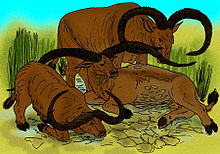Pelorovis
| Pelorovis | |
|---|---|

| |
| Pelorovis oldowayensis Skull | |
| Scientific classification | |
| Domain: | Eukaryota |
| Kingdom: | Animalia |
| Phylum: | Chordata |
| Class: | Mammalia |
| Order: | Artiodactyla |
| Family: | Bovidae |
| Subfamily: | Bovinae |
| Genus: | †Pelorovis Reck, 1928 |
| Species | |
| |
Pelorovis ("prodigious/monstrous
Taxonomy
The genus was first described by
The species P. kaisensis was named in 1994 from Kaiso, Uganda. Hadjouis and Sahnouni considered it to be closer to Syncerus in 2005.[3]
Systematics
A 2007 study by Bienvenido Martínez-Navarro and colleagues of the
A 2018 study by Tong et al. of the Chinese fossil representation of Bos primigenius uses morphology to dispute these conclusions regarding these taxa belonging to the genus Bos, as well as if they are the ancestral line from which Bos evolved, instead hewing to the traditional interpretation that the Indian Early Pleistocene fossil species Bos acutifrons is the primordial ancestor of Bos.[6]
In 1949,
Etymology
The
Description

Pelorovis resembled an
P. oldowayensis was broadly the same size as modern African buffalo, but its legs were longer, and the elongated head of this species was reminiscent to those of the modern Alcelaphinae.
Distribution
P. oldowayensis occurred in sub-Saharan Africa and disappeared 800,000 years ago. The best fossils of P. oldowayensis are known from the Olduvai Gorge in Tanzania.
See also
References
- ISBN 9780691156828. Retrieved 2022-08-25.
- ^ ISBN 0-231-11944-5(pp. 159-167)
- ^ S2CID 55104027. Retrieved 8 January 2020.
- . Retrieved 3 January 2020.
- ^ Hassanin, Alexandre (January 2014). "Systematic and evolution of Bovini". In Melletti, D.R.; Burton, J. (eds.). Ecology, Evolution and Behaviour of Wild Cattle: Implications for Conservation. Cambridge University Press. pp. 7–21.
- . Retrieved 4 January 2020.
- ^ Duvernoy, Georges Louis (December 1851). "note sur une espèce de buffle fossile [Bubalis (Arni) antiquus], découverte en Algérie, caractérisée et décrite par M. Duvernoy". Comptes rendus hebdomadaires des séances de l'Académie des Sciences (in French). 33: 595–597. Retrieved 8 January 2020.
- . Retrieved 8 January 2020.
- .
- ISBN 9780674431256.
- S2CID 55104027. Retrieved 8 January 2020.
- .
- .
- ^ Liddell, Henry George; Scott, Robert (1940). "πέλωρ-". A Greek–English Lexicon. Oxford: Clarendon Press.
- . Oxford: Clarendon Press.
- ISBN 978-1-84028-152-1.
